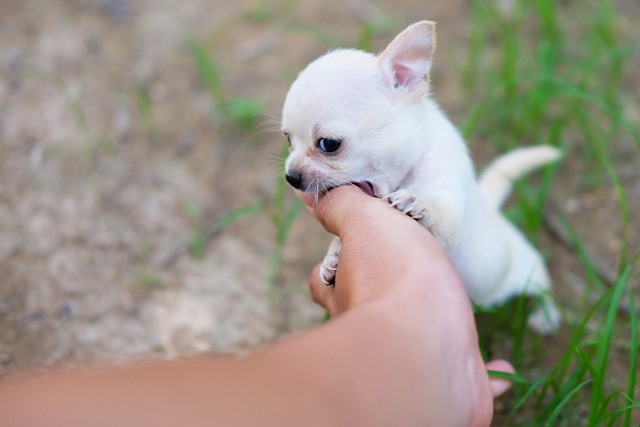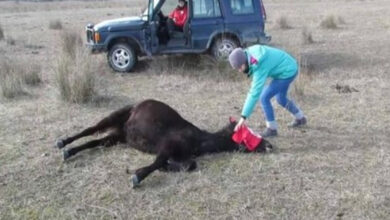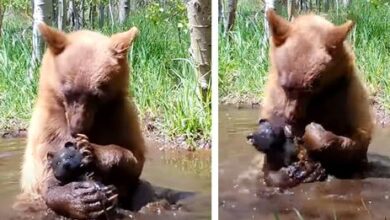How To Cope With Teething: What To Expect And What To Do

HOW TO DEAL WITH THE TEETH
Whether you are a first-time dog owner or a seasoned pet companion, there are few things as exciting as bringing home a new puppy. Watching your new friend explore your home, try new foods, and learn how to wag your tail can be incredibly adorable. Now is the perfect time for you and your family to bond with your new dog and start making a connection that will last a lifetime.
However, after the first few weeks have passed, you may begin to wonder: when will the teething begin? Chances are you’ve heard the rumors about puppies and teething – it could be the worst. Images of mangled shoes, ragged sofas, or knotty clothes may cross your mind. The intimidating idea of a puppy teething is enough to make even expert dog owners shudder.
If you are wondering about teething, you might be wondering what exactly can I expect? Also, what can I do about it? If you’re feeling a little overwhelmed with how to deal with teething, don’t worry, we’ve all been there.
The good news is that while teething can be an uncomfortable time for you and your dog, there are plenty of tips and tricks to help make the transition as smooth as possible. Stay with us to learn how to identify when your puppy started teething and how to manage to teethe.
IS MY PUPPY A DENTIST?
The first and sometimes the most intimidating question you probably ask yourself is, “Is my puppy teething?” “. Fortunately, the signs of teething are not difficult to identify. While each breed can be somewhat different, in general, all puppies follow the same timeline.
When you ask yourself “Is my puppy teething?” The first thing to know is the general chronology. The majority of dogs fall within this range of development. By checking where your puppy is on the timeline, you can begin to estimate when teething will begin. If your puppy is too young or too old to teething, you can most likely rule out teething as an explanation for his behavior.
DENTITION SCHEDULE
Understanding the value of timeline, here is the general journey of puppy development and dental health:
2 to 4 weeks: Puppies develop their baby teeth during their first month. This will usually happen while you are still in the care of the breeder, so it will not impact living at home with you.
5 to 6 weeks: By the end of their second month, puppies should have all of their baby teeth. There will be around 28 baby teeth in total.
12 to 16 weeks: This is the perfect place to start teething. Around 3 months of age, most puppies begin the teething process. If your puppy is three or four months old, expect teething to begin. It should last from one to three months.
24 weeks and older: By 6 months of age, most puppies will be finished teething. They should have 42 adult teeth in their mouths; if there are a lot fewer teeth than that, your dog is still teething. Although rare, some dogs take up to 9 months to finish teething.
SIGNS YOUR PUPPY HAS TOOTHPASTE
Familiarizing yourself with the timeline above is a great way to prepare for the inevitable start-up phase. While useful, it always leaves a window of uncertainty – even if your puppy is on time to teething, how can you be sure?
In addition to the timeline, there is a myriad of signs you can look out for to answer whether your puppy is teething. Fortunately, they’re all pretty straightforward to identify – and most are universal in all dogs – so if you think it’s a sign of teething, there’s a good chance it is.
The first and most obvious sign is chewing. When your dog enters the teething phase, he’ll want to chew just about anything. On a physical level, this is because chewing can provide relief from the discomfort of loose baby teeth and adult teeth piercing gums. Try to remember that your puppy is not trying to be playful by chewing on your shoes or gnawing at your furniture, but is just trying to relieve some pain.
If you notice an increase in chewing behavior or start to see more things being chewed or gnawed around your house, it should be a giant flag indicating that your puppy has started teething.
In addition to chewing, you can tell if your puppy is teething by looking for the following signs:
- Increased drooling
- Small bloodstains on your dog’s toys
- Red or swollen gums
- Increased crying or crying
- Find baby teeth in the house
- Have a mild fever
- Change in the timing of meals (usually slowed down)
- Soft stool
Each of these indicators indicates teething, although it is important to note that not all of them will manifest in every dog. If you can tick off one or two, besides the right timing and increased chewing, then congratulations, your puppy has started teething.
HOW TO TREAT TEETH
If knowing when your puppy is teething is half the battle, then the other half is how to cope. Fortunately, there are many options available to help your dog get through this uncomfortable time. There are three main points to remember when learning to manage to teethe:
- Chews and toys,
- Soothing gums, and
- Positive reinforcement.
CHEW AND TOYS
The most important way to deal with teething is to provide plenty of chew toys. When teething your dog goes through a very uncomfortable process and chewing is one of the only relief. That’s why your dog can start chewing just about anything (including yourself!) To help ease some of the pain.
If you don’t provide the right things for your puppy to chew on, there’s a good chance he’ll find something. This is where most teething horror stories come in: People didn’t know how to deal with their dog’s teething, and so their four-legged friend got into something they didn’t. shouldn’t have.
Fortunately, you can prevent this by giving your dog the right toys to chew on. There are many chew toy options to offer, including:
Plush toys (such as stuffed animals)
- Rubber toys
- Plastic toys
- Chew sticks
- Rawhide bone
When shopping for these chew toys, remember: variety is key. Your dog will need different textures, firmness, and strength depending on the pain he is feeling. If you don’t have a toy that can satisfy their teething pain, they’ll usually go for something that does.
We recommend that you purchase several types of toys to have on hand. In general, make sure you always have something:
- Hard,
- Soft and
- Edible.
By covering these three basics, you will generally have exactly what you need to deal with your dog’s chewing.
SOOTHING GUMS
Another important part of treating teething is to help soothe your dog’s gums. The gums are where your dog will feel the most pain; after al, bones arere running through the walls of the gums.
While chew toys are a great way to ease pain, they aren’t always enough to soothe your dog. As such, it is important to prepare items that are specially designed to help soothe the gums as well. Just as ice helps our bodies deal with swelling and pain, cold toys and treats are great for helping with teething.
Most pet stores carry toys and treat designed to be frozen. Consider picking up some of these to have them handy. Alternatively, healthy frozen foods are also suitable for teething dogs. You may want to freeze a carrot or blueberries to provide a healthy, soothing snack for your puppy.
If all else fails, ice cubes are always a foolproof option. Your dog can chew them, suck them, or just place their gums on ice. Don’t be fooled into thinking it’s too simple: Many owners report that ice cubes are one of the most effective tools to help soothe the gums.
During this whole process, remember to be patient and kind to your puppy. While it can be frustrating to deal with teething, try not to forget what it must be like for your furry friend. Just as human babies feel discomfort with teething, so do baby dogs; do your best to soothe and comfort your puppy whenever possible.
POSITIVE REINFORCEMENT
The third tip on how to manage to teethe is the practice of positive reinforcement.
Since your puppy is still in the early stages of development, teething is a great time to start building habits and continue your training. You can use teething as a chance to teach what is and is not appropriate for your puppy to do.
For example, if you find your puppy gnawing at furniture, you can teach him not to chew on furniture by giving him a chew toy instead. Your puppy will quickly learn what should and shouldn’t be chewed and there’s a good chance he’ll prefer the toy anyway.
During this time, you might be tempted to start using negative reinforcement when you’re doing something wrong. It is like punishing your puppy when he chews a shoe or grabbing his mouth when he nibbles. While it can be understandable that you are upset, it can set an unhealthy precedent for behavior. Your puppy may grow up fearful or resentful of the hands around his mouth, for example, which may cause more behavior problems in the future.
Instead, consider focusing on positive reinforcement as a tool to help cope with teething. Reward your puppy for chewing on the right things and gently encourage him to gnaw on something else when he behaves badly. Dogs are wired to respond well to positive reinforcement, and using it will not only train your dog but also strengthen your bond.
SOME WARNINGS WITH TEETHING
When your puppy starts teething, it’s important to be prepared for a few possible issues. Knowing some of the warnings that come with teething can help you better manage them if (and when) they happen.
BLOOD: A LITTLE IS NORMAL
The first warning to be prepared for is blood. Although it can be upsetting at first, some blood during teething is quite normal. You will likely see small blood stains on your dog’s toys, as well as dripping blood around the house.
Although we are programmed to associate the blood with serious problems, a little is still normal. There can be a lot of reasons for the blood; part of the gum tissue can tear when a baby tooth comes loose or when an adult tooth pushes through. If seeing the bloodstains bothers you, try remembering that this is a natural, healthy part of teething.
Of course, if you see more than a few drops of blood, it could be a sign that something more serious is going on. In a situation like this, call or visit your vet as soon as possible to get professional advice and make sure your dog is developing properly.
PROTECT YOUR PROPERTY!
The next warning should be straightforward: protect the possessions that you don’t want to risk destroying.
Even when you have a myriad of chew toys ready for your puppy, sometimes you just can’t stop your dog from getting into something he shouldn’t. If you can’t stand having an expensive family cabinet or couch eaten away, be sure to keep them away from your teething dog. Likewise, clothing and shoes should be removed from the ground and kept out of your puppy’s reach.
Some people are successful in using baby gates to separate parts of their house from their teething dogs. If you are wondering how to manage to teethe, this may be a great option for you. More than anything, remember that by adopting a puppy you are accepting the risk of them chewing something that you don’t want them to bite.
PINCHING IS NORMAL
The third warning to watch out for is the pinch. As your puppy develops its adult teeth, it is almost certain that it will start to nibble. It is natural for your dog to test his new teeth and educate himself on the proper limits. While pinching is normal, you need to be prepared to set the precedent right from the start so that they don’t pinch you. Failure to do so could mean developing a habit that is harder to break.
If your puppy starts to bite you, let out an “Ouch!” High pitched. to let them know they bit too hard. This is similar to what other puppies and dogs will do to each other when they play. If the noise turns your dog on, be sure to act calmly and turn away or stop playing. Your puppy will quickly learn what is and is not okay with nibbling.
Some experts suggest buying toys that are at least twice the size of your puppy’s head to help them a nibble. This will reduce the chances of your hand coming into contact with your furry friend’s mouth. While this is a great way to protect yourself from biting, it’s still important to be prepared to actively teach your puppy not to bite.
TEETH: TOGETHER YOU CAN DO IT!
By now you should feel more comfortable answering the questions “Is my puppy teething” and “How do I deal with teething?” Remember, preparation is key – the more available for your dog, the better his teething experience will be. Even if the going gets tough, teething only lasts a few weeks. Try to keep this in mind and enjoy every stage of the life that you and your puppy live together.
What has helped you during the teething process? Let us know in the comments below!





